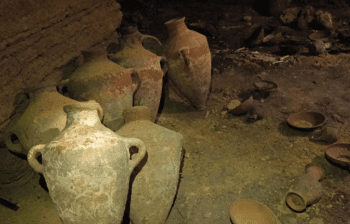Archaeologists have discovered an intact burial cave dating to the time of Ramses II, who is believed to be the pharaoh in the biblical book of Exodus.
Eli Yannai, an expert on the Bronze Age at the Israel Antiquities Authority, called the discovery a “find of a lifetime.” “It’s like a set from ‘Indiana Jones’ — a cave with vessels on the floor that haven’t been touched for 3,300 years,” Yannai said, according to Haaretz.
“The period is the Late Bronze Age, exactly the time of the notorious pharaoh, Ramesses II,” he said. “The cave provides a full picture of burial traditions in the Late Bronze Age.”
Ramesses II, also known as Ramesses the Great, reigned from about 1279 B.C. to 1213 B.C. The pharaoh is believed to have expanded ancient Egypt’s influence as far as modern Syria to the northeast and Sudan to the south. This means that at one point, Israel was under Egyptian rule.
The burial chamber had been carved into the bedrock in the form of a square, with a pillar supporting its ceiling. In contrast to (slightly earlier) burials found in the vicinity of Israel’s southern coast, it seems to have served a family or clan, Yannai says.
Other graves, albeit from the 14th century B.C.E., not the 13th, each served to inter one body. However, not much more about the bodies can be said: in contrast to the grave site itself, their preservation is poor, precluding the possibility of D.N.A. extraction and analysis.
That said, Yannai believes it reasonable to assume that they were local people living on the coast, who – based on some of the grave goods – had a brisk trading relationship with Cyprus, Lebanon, and Syria.

According to The Christian Post, Yannai noted that the ancient cave offers a “full picture” of burial traditions during that period. The discovery of the cave, which was at the construction site of Palmahim Beach National Park on the southern Israeli coast, took place by accident after a tractor moved a rock and revealed the cave’s ceiling.
The cave was filled with a variety of items, including amphorae, different kinds of bowls, cooking vessels, and oil lamps, The Jerusalem Post reports. According to archaeologists, these artifacts were believed to have served the dead in the afterlife.
Other items in the ancient burial cave were tiny vessels with substances that may have come from Tyre, Sidon, and other ports in Lebanon. The archeologists also found bronze spear tips and arrowheads. “In the cave, mainly dozens of pottery vessels of various sizes and shapes were left,” Yannai said.
He added that the vessels contained shallow bowls, cooking pots, jugs, and clay candles with oil for light. According to Live Science, the I.A.A. did not confirm whether human remains, inscriptions, or identifying artifacts were found in the ancient cave.
“The news of the discovery of the cave spread like wildfire in the academic world, and we have already received requests from many scholars to take part in the planned archaeological excavation,” I.A.A.’s director-general Eli Eskosido and Israel Nature and Parks Authority director Raya Shurky said in a statement.


